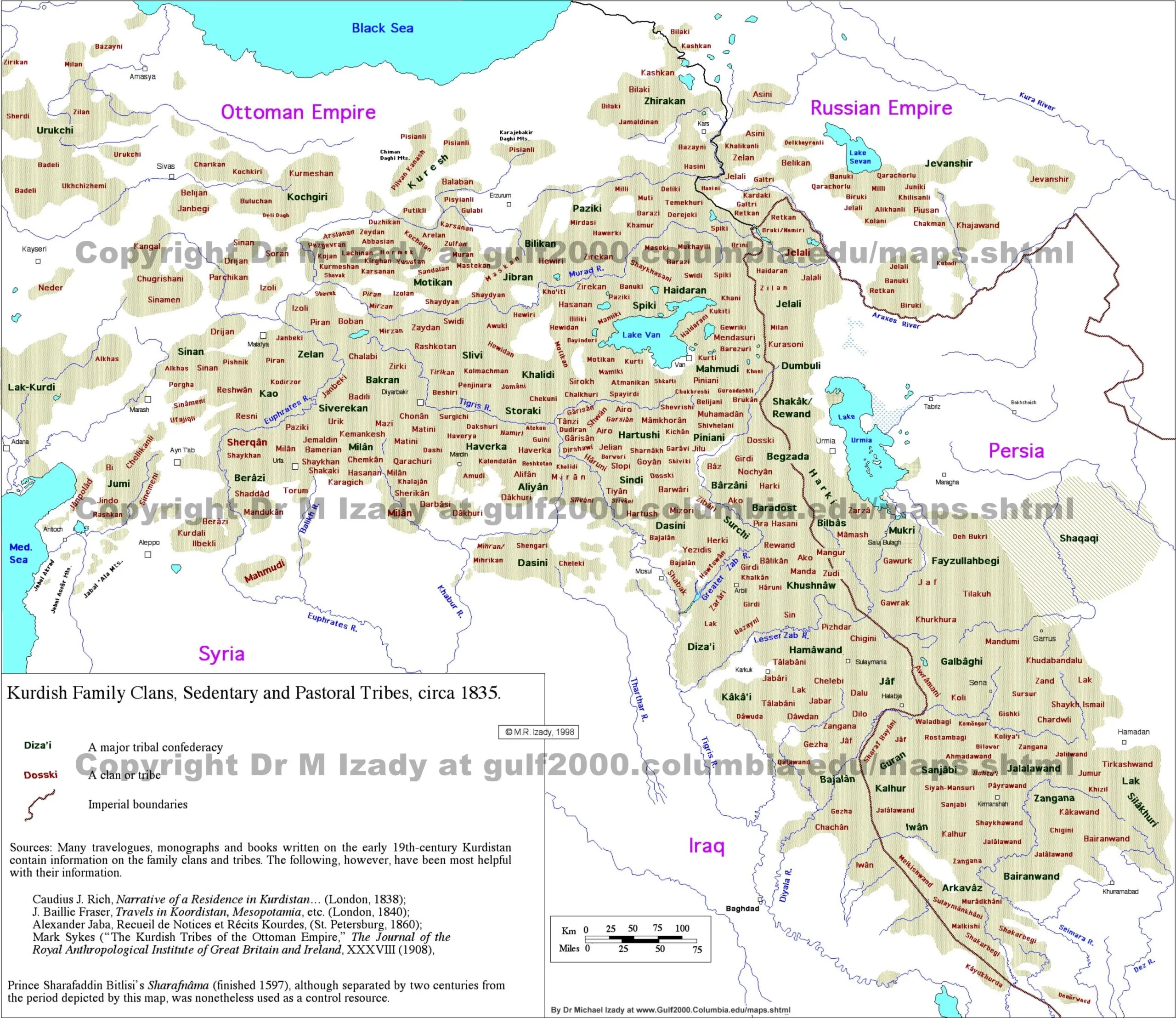M R Izady
A. Introduction and a survey of the relevant primary sources:
Detailed study of clan names among the Kurds reveals an etymological affinity among a majority of them. The very same ethnonyms, or variations thereof, are also found in the names of many ruling dynasties, historical individuals, and toponyms dispersed over a large area of Western Asia, some dating back to remote antiquity. Equally important is the frequent incidence of these same names among neighboring ethnic groups and cultures that are not Kurdish. These archaic progenitic names I will refer to henceforth in this survey as protonyms, standing roughly for "formative root-names," what is known as onomasticon in classical Greek. As a convenient marker, the protonyms will carry an asterisk.
The incidence of these protonyms in toponyms and ethnonyms in non-Kurdish regions is most frequent in the southern Zagros. This is the mountainous area that now includes the territories of Luristan, Bakhtiyari, Kuh Giluya, Boir Ahmadi, Mamasani, Junaki, Mand, Fars (ancient Pars/Persis), and Shabankara in western Kirman near the Straits of Hormuz (Map 1). The incidence of these protonyms across many ethnic boundaries and many ages can be explained only through transplantation by migrations of groups who were then assimilated into local ethnic groups, leaving behind only the ever-evolving protonyms as “calling cards."
Until relatively recently, a large number of the inhabitants of the mountain ranges of southwest Asia practiced pastoral nomadism, which entailed great physical mobility. This phenomenon surely included the Kurds. Pastoralists routinely moved into new territories when conditions were more favorable there. This survey indicates that those people who carried the protonyms as their identity, be they pastoralists or otherwise, settled most of the local mountain systems. A very large number of these were eventually assimilated, hence the incidence of the protonyms among different ethnic groups.
Protonyms have been and continue to be used most frequently in Kurdistan and among its inhabitants. It is therefore logical to assume that they are the primary originators of the protonyms. This ethnic group has constituted the numerical majority of all the mountain inhabitants of the Zagros-Taurus systems for a very long time. Thus, in tracing the distribution of the protonyms, we are mainly mapping the past population movements of the Kurds, but also some of the common ancestors of modern local ethnic groups such as the Baluch, Lur, and Gilanis.
Even though impressive in the geographical extent of their migrations, these episodes of population movement and territorial expansion are dwarfed by those registered by the Turkic and Arabian nomads. As steppe and desert (horizontal) nomads, they expanded many thousands of miles from their original homelands. Kurdish pastoralists, being mountain (transhumant, or vertical) nomads, expanded only in the relatively limited mountain environment. Any large intervening gaps normally hindered their expansion even into the next mountain system. The vast Barez-Zagros-Taurus mountain systems (respectively meaning: “High”, and “the Sagarthians'' in the Iranic languages, and the last one from the Aramaic “Tur”, meaning a mountain) was the most natural route of expansion, and the majority of protonyms are concentrated in that region. The Alburz, Caucasus, and the Amanus could be reached only by overcoming intervening narrow gaps of steppes, and they yield many fewer protonyms. The wide tract of steppes (Meshhad-Herat gap) has rendered the Parapamisus and the Hindu Kush relatively free of the protonyms. (Map 2)
It is important to recognize that, here at least, the term “clan or tribe" should by no means be equated with nomad, or “tribal" with nomadic life-style. A majority of Kurds have by necessity always been farmers and town-dwellers throughout the long history of that society. As a rule of thumb, the originators of any given protonym were more likely to have been sedentary people than pastoralists, although the latter were the likely vehicle for their wide distribution.
Please access this link to read the article in full version
The first two parts of this four part study were originally published in The International Journal of Kurdish Studies (New York, 1993-4), vols 6-7.
This partially expanded version of the first two portions are being re-published here in 2021

